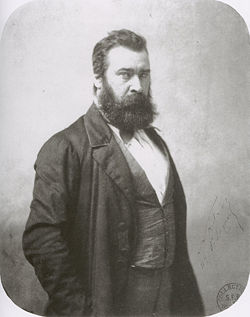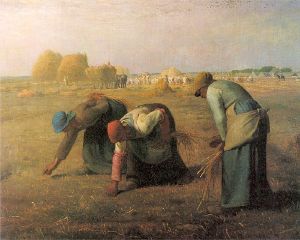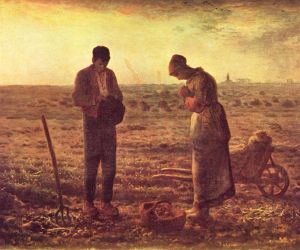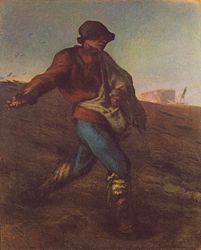Millet, Jean-Francois
Mihir Shah (talk | contribs) |
Mihir Shah (talk | contribs) |
||
| Line 31: | Line 31: | ||
==Influence of Other Artists== | ==Influence of Other Artists== | ||
| − | Jean-Francois Millet painted particularly original works; however, some of the artistic aspect of his painting can be attributed to the | + | Jean-Francois Millet painted particularly original works; however, some of the artistic aspect of his painting can be attributed to the influence of Rousseau's The ''Porte aux Vaches'' in snow, and Baroque Painter Louis Le Nain. His ''Winnower'' is a clear example of his imitation of Le Nain, whose paintings consisted mostly of family life. The emphasis on color is evident and the monumentality of the figures in comparison to their landscape is also prevalent. Rousseau's use of landscape can be seen in many of Millet's preparatory drawings with its open, central vista and horizontally banded, linear composition formed by the trees in the background. |
| + | |||
==Millet's Painting== | ==Millet's Painting== | ||
===Political Controversy=== | ===Political Controversy=== | ||
| Line 41: | Line 42: | ||
One of the most well known of Millet's paintings is ''The Gleaners'' (1857), depicting women stooping in the fields to glean the leftovers from the harvest. It is a powerful and timeless statement about the working class. ''The Gleaners'' is on display in [[Paris]]'s Musée d'Orsay. | One of the most well known of Millet's paintings is ''The Gleaners'' (1857), depicting women stooping in the fields to glean the leftovers from the harvest. It is a powerful and timeless statement about the working class. ''The Gleaners'' is on display in [[Paris]]'s Musée d'Orsay. | ||
| − | Picking up what was left of the harvest was regarded as one of the lowest jobs in society. However, Millet | + | Picking up what was left of the harvest was regarded as one of the lowest jobs in society. However, by focusing strictly on the rugged curves of the figures and the brutal hunching of the backs, Millet portrayed these women as heroic figures. This is distinctly different than the standard, where servants were depicted in paintings as subservient to a noble or king. Here, light illuminates the women's shoulders as they carry out their work. Behind them, the field that stretches into the distance is bathed in golden light, under a wide, magnificent sky. The forms of the three figures themselves, nearly silhouetted against the lighter field, show balance and harmony. |
| + | |||
==='''Harverster's Resting'''=== | ==='''Harverster's Resting'''=== | ||
| Line 51: | Line 53: | ||
The disparity between the apparent value of the painting and the poor estate of Millet's surviving family was a major impetus in the invention of the droit de suite, intended to compensate artists or their heirs when works are resold. | The disparity between the apparent value of the painting and the poor estate of Millet's surviving family was a major impetus in the invention of the droit de suite, intended to compensate artists or their heirs when works are resold. | ||
| + | |||
| + | One critic, Charles Tardieu said of the painting, | ||
| + | "masterpiece, and one of the masterpieces of contemporary | ||
| + | art; a Realist painting certainly, but perhaps not as | ||
| + | much as was first thought. The realism that lies in the | ||
| + | provinciality of the subject, in the triviality of the figures, is | ||
| + | then idealized, not only by the emotion with which the | ||
| + | painter has translated his religious impression and the | ||
| + | power of his two laborers' naive faith.... The prayer in it is so | ||
| + | vigorously known that it appears, by the will of the artist, | ||
| + | instilled there not only through the two peasants and their | ||
| + | bowed poses, but even in the soil that they work, in this | ||
| + | landscape of resigned austerity, even for the most skeptical | ||
| + | of viewers." <ref> Fratello, Bradley. ''The Art Bulletin: France embraces Millet: the intertwined fates of The Gleaners and The Angelus.'' </ref> | ||
The Angelus was reproduced frequently in the 19th and 20th centuries. [[Salvador Dalí]] was fascinated by this work, and wrote an analysis of it, ''The Tragic Myth of The Angelus of Millet''. Rather than seeing it as a work of spiritual peace, Dalí believed it held messages of repressed sexual aggression. Dalí was also of the opinion that the two figures were praying over their buried child, rather than to the Angelus. Dalí was so insistent on this fact that eventually an X-ray was done of the canvas, confirming his suspicions: the painting contains a painted-over geometric shape strikingly similar to a coffin. (Néret, 2000) However, it is unclear whether Millet changed his mind on the meaning of the painting, or even if the shape actually is a coffin. | The Angelus was reproduced frequently in the 19th and 20th centuries. [[Salvador Dalí]] was fascinated by this work, and wrote an analysis of it, ''The Tragic Myth of The Angelus of Millet''. Rather than seeing it as a work of spiritual peace, Dalí believed it held messages of repressed sexual aggression. Dalí was also of the opinion that the two figures were praying over their buried child, rather than to the Angelus. Dalí was so insistent on this fact that eventually an X-ray was done of the canvas, confirming his suspicions: the painting contains a painted-over geometric shape strikingly similar to a coffin. (Néret, 2000) However, it is unclear whether Millet changed his mind on the meaning of the painting, or even if the shape actually is a coffin. | ||
| + | |||
==Major Works== | ==Major Works== | ||
Revision as of 17:58, 29 August 2007
| Jean-François Millet | |
 Portrait of Millet by Nadar. Date unknown, 1850-1870 | |
| Birth name | Jean-François Millet |
| Born | October 4 1814 Gruchy, Gréville-Hague, Normandy |
| Died | January 20 1875 |
| Nationality | French |
| Field | Painting, Sculpting |
Jean-François Millet (October 4, 1814-January 20, 1875) was a French painter whose style tightroped the line between naturalism and realism. He was also one of the founders of the Barbizon school in rural France. His pimary subject matter dealt with scenes of peasant farmers.
Millet's Biography: Path to Fame
Jean François Millet was born in Gruchy near Gréville on Oct. 4, 1814. Much of his life endeavors concentrated on peasant subject matter because of the influence of his childhood. As a child, Millet grew up in a heavy-labor environment: farming to make a living. Knowing what it was like to live in poverty, Millet moved to Paris with aspirations of painting. To learn the traditions of classical and religious painting, he entered the studio of Paul Delaroche, a successful academic imitator of the revolutionary romanticist Eugène Delacroix. However, Delaroche refused to take Millet under his wing. Millet, however, stayed in Paris, supporting himself by making pastel reproductions of rococo masters, occasional oil portraits, and commercial signs. He studied with two painters from his home town of Cherborg, Bon Dumouchel and a copyist, Lucien-Theophile Langlois. Four years later, in 1841, Millet married Pauline Ono. The marriage only lasted for three years, interrupted terminally by the death of Ono. He remarried in 1845, to Catherine Lemaire. He exhibited much of his work in the Parisian Salons and one of his works were even accepted by the Salon of 1840. One of his premier works was the ‘’Winnower.’’
In the early stages of his career, Millet’s subject matter was more on a classical and religious level. However, during the decade of the 1840’s, he gained the support of his contemporaries, and thus, began to work on paintings for which he is now most known: of the pesantry. Among these were Narcisse Diaz de la Peña and Théodore Rousseau, two landscape painters who were instrumental in forming the Barbizon school. Millet and the other Barbizon artists resisted the grand traditions of classical and religious painting, preferring a direct, unaffected confrontation with the phenomena of the natural world. Millet moved to Barbizon in 1848. The picturesque village became his home for the rest of his life, and he died there on Jan. 20, 1875. During that period he produced his most mature and celebrated paintings, including the Gleaners (1857), the Angelus (1857-1859), the Sower (1850), and the Bleaching Tub (ca. 1861). The works are characterized by their simplicity; they generally depict one or two peasant figures quietly working in the fields. With sweeping, generalized brushwork and a monumental sense of scale, Millet gave his figures a unique sense of dignity and majesty.
During the late 19th century Millet's paintings became extremely popular, particularly among American audiences and collectors. As more radical styles appeared, however, his contribution became partially eclipsed; to eyes accustomed to impressionism and cubism, his work appeared sentimental and romantic.
Influence of Other Artists
Jean-Francois Millet painted particularly original works; however, some of the artistic aspect of his painting can be attributed to the influence of Rousseau's The Porte aux Vaches in snow, and Baroque Painter Louis Le Nain. His Winnower is a clear example of his imitation of Le Nain, whose paintings consisted mostly of family life. The emphasis on color is evident and the monumentality of the figures in comparison to their landscape is also prevalent. Rousseau's use of landscape can be seen in many of Millet's preparatory drawings with its open, central vista and horizontally banded, linear composition formed by the trees in the background.
Millet's Painting
Political Controversy
While Millet's legacy as an adamant working-class supporter is engraved in stone, he did not lack his share of critics. In fact, it took a very long time for people to realize that Millet had no political intensions. Millet's work carried an aura of spirituality that few artists could match, but this spirituality was often mistaken for political propoganda. The works he received the most criticism for included his most famous work, Gleaners, "Sower and the Hay Trussers. An anonymous critic accused Millet of depicting labor as a horrifying nightmare by emphasizing the ragged clothes of the peasants and putting the central focus on the misery of the peasant worker. A more known critic, Sabatier-Ungher said, The earth is fertile, it will provide, but next year, like this, you will be poor and you will work by the swear of your brow, because we have so arranged it that work is a curse. In other words, Millet is trying to awaken the oblivious peasants that this will be the way they live for their entire life. He, as critics often claimed, solidified the permanence of labor, and portrayed it as a never-ending plight of the peasant worker. During the 1850's and 1860's, Millet's work was considered a revolution of its own, compared to the French Revolution. One of the harshest of his critics, Paul de Saint-Victor, observed that one would have to look for a long time before one found a living example of his Man with a hoe, shown at the Salon of 1863 “Similar types,’ he wrote, ‘are not even seen in a mental hospital.' His most celebrated work, The Gleaners, shown at the salon of 1857, however was considered pretentious. The figures were ‘the three fates of pauperism; moreover, they had no faces and looked like scarecrows.
The Gleaners
One of the most well known of Millet's paintings is The Gleaners (1857), depicting women stooping in the fields to glean the leftovers from the harvest. It is a powerful and timeless statement about the working class. The Gleaners is on display in Paris's Musée d'Orsay.
Picking up what was left of the harvest was regarded as one of the lowest jobs in society. However, by focusing strictly on the rugged curves of the figures and the brutal hunching of the backs, Millet portrayed these women as heroic figures. This is distinctly different than the standard, where servants were depicted in paintings as subservient to a noble or king. Here, light illuminates the women's shoulders as they carry out their work. Behind them, the field that stretches into the distance is bathed in golden light, under a wide, magnificent sky. The forms of the three figures themselves, nearly silhouetted against the lighter field, show balance and harmony.
Harverster's Resting
The Angelus
Commissioned by a wealthy American, Thomas G. Appleton, and completed during the summer of 1857, Millet added a steeple and changed the initial title of the work, Prayer for the Potato Crop to The Angelus when the purchaser failed to take possession in 1859. Displayed to the public for the first time in 1865, the painting changed hands several times, increasing only modestly in value, since some considered the artist's political sympathies suspect. Upon Millet's death a decade later, a bidding war between the US and France ensued, ending some years later with a price tag of 800,000 gold francs.
The disparity between the apparent value of the painting and the poor estate of Millet's surviving family was a major impetus in the invention of the droit de suite, intended to compensate artists or their heirs when works are resold.
One critic, Charles Tardieu said of the painting, "masterpiece, and one of the masterpieces of contemporary art; a Realist painting certainly, but perhaps not as much as was first thought. The realism that lies in the provinciality of the subject, in the triviality of the figures, is then idealized, not only by the emotion with which the painter has translated his religious impression and the power of his two laborers' naive faith.... The prayer in it is so vigorously known that it appears, by the will of the artist, instilled there not only through the two peasants and their bowed poses, but even in the soil that they work, in this landscape of resigned austerity, even for the most skeptical of viewers." [1]
The Angelus was reproduced frequently in the 19th and 20th centuries. Salvador Dalí was fascinated by this work, and wrote an analysis of it, The Tragic Myth of The Angelus of Millet. Rather than seeing it as a work of spiritual peace, Dalí believed it held messages of repressed sexual aggression. Dalí was also of the opinion that the two figures were praying over their buried child, rather than to the Angelus. Dalí was so insistent on this fact that eventually an X-ray was done of the canvas, confirming his suspicions: the painting contains a painted-over geometric shape strikingly similar to a coffin. (Néret, 2000) However, it is unclear whether Millet changed his mind on the meaning of the painting, or even if the shape actually is a coffin.
Major Works
External links
- Maura Coughlin's article on Millet's Norman milkmaids
- Influence on Van Gogh
- Influence on Dali - grieving parents or praying peasants in The Angelus?
| Persondata | |
|---|---|
| NAME | Millet, Jean-François |
| ALTERNATIVE NAMES | Millet, Jean-François |
| SHORT DESCRIPTION | French painter and one of the founders of the Barbizon school |
| DATE OF BIRTH | October 4 1814 |
| PLACE OF BIRTH | Gruchy, Gréville-Hague, Normandy |
| DATE OF DEATH | January 20 1875 |
| PLACE OF DEATH | |
Credits
New World Encyclopedia writers and editors rewrote and completed the Wikipedia article in accordance with New World Encyclopedia standards. This article abides by terms of the Creative Commons CC-by-sa 3.0 License (CC-by-sa), which may be used and disseminated with proper attribution. Credit is due under the terms of this license that can reference both the New World Encyclopedia contributors and the selfless volunteer contributors of the Wikimedia Foundation. To cite this article click here for a list of acceptable citing formats.The history of earlier contributions by wikipedians is accessible to researchers here:
The history of this article since it was imported to New World Encyclopedia:
Note: Some restrictions may apply to use of individual images which are separately licensed.
- ↑ Fratello, Bradley. The Art Bulletin: France embraces Millet: the intertwined fates of The Gleaners and The Angelus.



